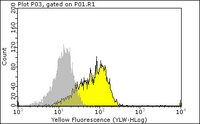MAB3061 Sigma-AldrichAnti-Fas Antibody, clone SM1/1
This Anti-Fas Antibody, clone SM1/1 is validated for use in FC, FUNC for the detection of Fas.
More>> This Anti-Fas Antibody, clone SM1/1 is validated for use in FC, FUNC for the detection of Fas. Less<<Produits recommandés
Aperçu
| Replacement Information |
|---|
Tableau de caractéristiques principal
| Species Reactivity | Key Applications | Host | Format | Antibody Type |
|---|---|---|---|---|
| H | FC, FUNC | M | Purified | Monoclonal Antibody |
| Description | |
|---|---|
| Catalogue Number | MAB3061 |
| Replaces | CBL527B |
| Brand Family | Chemicon® |
| Trade Name |
|
| Description | Anti-Fas Antibody, clone SM1/1 |
| Alternate Names |
|
| References |
|---|
| Product Information | |
|---|---|
| Format | Purified |
| Presentation | Purified IgG provided in PBS, no preservatives. |
| Quality Level | MQ100 |
| Physicochemical Information |
|---|
| Dimensions |
|---|
| Materials Information |
|---|
| Toxicological Information |
|---|
| Safety Information according to GHS |
|---|
| Safety Information |
|---|
| Storage and Shipping Information | |
|---|---|
| Storage Conditions | Maintain at 2-8°C in undiluted aliquots. After opening, aliquot and freeze at -20°C. Avoid repeated freeze/thaw cycles. |
| Packaging Information | |
|---|---|
| Material Size | 100 µg |
| Transport Information |
|---|
| Supplemental Information |
|---|
| Specifications |
|---|
| Global Trade Item Number | |
|---|---|
| Référence | GTIN |
| MAB3061 | 04053252663857 |
Documentation
Anti-Fas Antibody, clone SM1/1 FDS
| Titre |
|---|
Anti-Fas Antibody, clone SM1/1 Certificats d'analyse
| Titre | Numéro de lot |
|---|---|
| Anti-Fas, clone SM1/1 - 1955313 | 1955313 |
| Anti-Fas, clone SM1/1 - 3864326 | 3864326 |
| Anti-Fas, clone SM1/1 - 4197627 | 4197627 |
| Anti-Fas, clone SM1/1 - NG1871315 | NG1871315 |
| Anti-Fas, clone SM1/1 Monoclonal Antibody | 3142457 |
Références bibliographiques
| Aperçu de la référence bibliographique | Nº PubMed |
|---|---|
| Inhibition of keratinocyte apoptosis by IL-15: a new parameter in the pathogenesis of psoriasis? Ruckert, R, et al J Immunol, 165:2240-50 (2000) 1999 | 10925312
 |
| Monoclonal antibody mediated tumor regression by induction of apoptosis {original article} Trauth, B et al Science, 245:301-305 (1989) 1988 | 2787530
 |
Brochure
| Titre |
|---|
| An Introduction to Antibodies and Their Applications |







